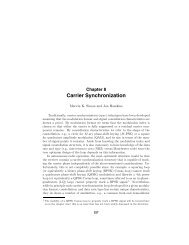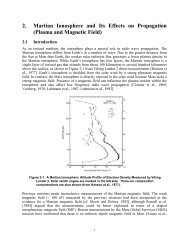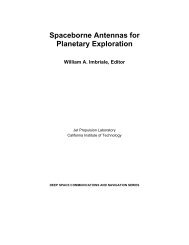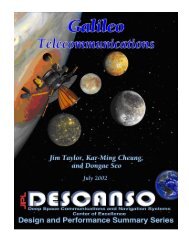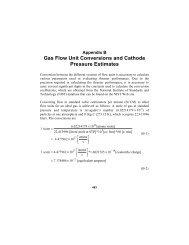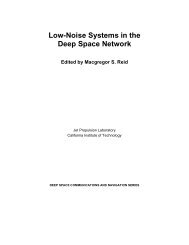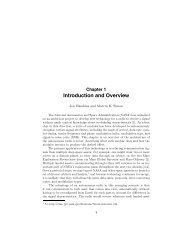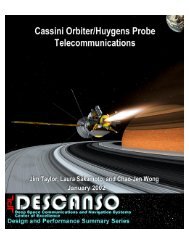Propagation Effects Handbook for Satellite Systems - DESCANSO ...
Propagation Effects Handbook for Satellite Systems - DESCANSO ...
Propagation Effects Handbook for Satellite Systems - DESCANSO ...
You also want an ePaper? Increase the reach of your titles
YUMPU automatically turns print PDFs into web optimized ePapers that Google loves.
develops (Pruppacher and Pitter-1971). Polarized microwave<br />
scattered from these particles can easily be converted into<br />
orthogonal polarization.<br />
energy<br />
an<br />
6.6.1.2 Measures of Depolarization. The measurement of<br />
depolarization by propagation researchers usually has been done<br />
utilizing orthogonally-polarized feeds on a single antenna while<br />
observing singly-polarized satellite signals. This parameter is<br />
called the cross-polarization discrimination (XPD) or crosspolarization<br />
ratio (XPR) defined as (Bostian, et al-1977)<br />
XPD = Power output from co-polarized Port<br />
power output from cross-polarized port<br />
= (XPR)-l<br />
For perfect transmitting and receiving antennas and a perfect medium<br />
this isolation could become, infinite, but with practical components<br />
some leakage is always present. Definitions and sample calculations<br />
of depolarization terms have been well documented in a tutorial<br />
report by Stutzman (1977).<br />
Un<strong>for</strong>tunately, the system designer desires the cross-polarization<br />
isolation (XPI) term defined as<br />
XPI (dB) = co-polarized signal power (dB)<br />
- cross-polarized signal power<br />
Fortunately, <strong>for</strong> most levels of attenuation<br />
(XPR)-l (Watson and Arbabi-1973).<br />
(dB) on the same channel<br />
observed, XPI = XPD =<br />
6.6.1.3 Depolarization Measurements. Most experimental<br />
depolarization data has been obtained from the 11.7 GHz right-hand<br />
circularly polarized Communications Technology <strong>Satellite</strong> (CTS)<br />
beacon, the 19.04 and 28.56 GHz linear polarized AT&T COMSTAR<br />
satellite beacons, and the 11.6 GHz circularly polarized SIRIO<br />
beacon.<br />
6-105





